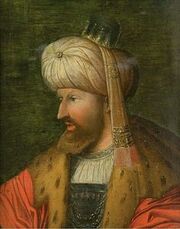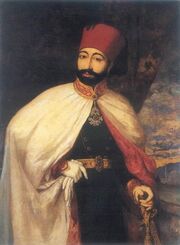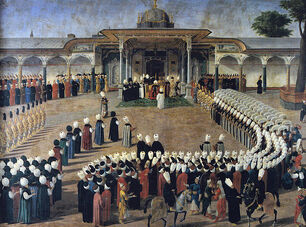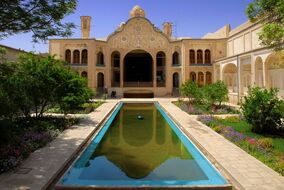
|
The following article is for use on Ruthenian Empire historic pages only. DO NOT delete this template or the pages that use it...
Please do not edit or alter this article in any way while this template is active. All unauthorized edits may be reverted on the author discretion. |
| Parsian Empire Pers İmparatorluğu | |||||
| 2588-3216 | |||||
| |||||
| 'Anthem: No Anthem | |||||
| Motto: Devlet-i Ebed-müddet "The Eternal State" | |||||
| Official language | Persian | ||||
| Demonym | Parsian | ||||
| Capital | Ostambal | ||||
| Largest city | Ostambal | ||||
| Government | Absolute Monarchy | ||||
| Sultan | Ostam (First) Yasif II (Last) | ||||
| Great Vizir | Ahmir Pasha (First) Omar Ladjim (Last) | ||||
| Religion | Aljukssi Islam | ||||
| Legislature | General Assembly | ||||
| Currency | Kurus | ||||
| History | |||||
| - Fondation | March 14, 1994 | ||||
| - Interregnum | December 30, 3171 | ||||
| - Fall of Ostambal | December 22, 3215 | ||||
| |||||
The Parsian Empire or the Empire of Parsia was a muslim state based in Bandria Granda Region in Eridana continent, placed in the old Kormenian territories gained after the Great war between the two countries, was finished with the dissolution of the Kormenian Empire and the annexation of all the Korimi territories, The Parsian himself is considered the succesor of the Imperial dignity and renamed his sultanate as Empire.
History[]
Fall of Beretea[]
After the conquest of Beretea, the Parsian formed a empire and called himself as Parsian Empire, successor of the Kormenian state and the greatest power in the Rothoi Peninsula. and dominate the region in the last 500 years, after a long interregnum who deeply weakened the sovereignty and Persian power, the dinasty of sultans were granted many liberties to peoples who had oppressed in the last century, and despite the efforts of shrewd administrators to preserve the state's integrity, the empire collapsed in September of 3215 after the Battle of Ostambal, where is last Sultan fell and begins the Enosis revolution and his fall.
During his almost one millenium of existence, The effective military and bureaucratic structures of the previous century came under strain during a protracted period of misrule by weak Sultans. The Parsians gradually fell behind the other countries in military technology as the innovation that fed the Empire's forceful expansion became stifled by growing religious and intellectual conservatism. But in spite of these difficulties, the Empire remained a major expansionist power until the Interregnum in 3171, which marked the end of Parsian cultural expansion and a period of decadence.
Caliphate[]

Mesud II, the first Caliph of Parsia
There numerous Sultans and after the fall of Kormenia, there was considered as Caliphate, being the Caliph one of the most important positions held by rulers of the Ostambik Dynasty. The caliphate symbolized their spiritual power, whereas the sultanate represented their temporal power. According to Parsian historiography, Mesud II acquired the title of caliph during his reign, and Mustafa I later strengthened the caliphal authority during his conquest of all the Peninsula. However, the general consensus among modern scholars is that Ostam rulers had used the title of caliph before the conquest of Kormenia, as early as during the reign of Ruzbeh, who brought most of the Rothoi peninsula under Parsian rule and established the title of sultan in 2360. It is currently agreed that the caliphate "disappeared" for two-and-a-half centuries, before being revived with the Treaty of Küçük Kaynarca, signed between the Parsian and Mauria in 2800. The treaty was highly symbolic, since it marked the first international recognition of the Parsian' claim to the caliphate. Although the treaty officialised, it acknowledged the Parsian caliph's continuing religious authority over Muslims in Ruthenia.
Interregnum[]
Emphasizes that for more than a millennium of administration, only one dynasty and ruled that was the central lace stability of the empire, the fall of the empire coincided with the fall of the dynasty, after the sudden death of Yasif II in a disease that nobody expected, his death caused a problematic political instability that led the Selloi rebelled and caused the downfall of the Parsian Empire.
After 700 years of prosperity, In 3171, the Sultan Nazif died and a period of interregnum provoked a fierce civil war between Parsian Aristocracy, that war Confederate nations managed to take some liberties as freedom of religion and the country began to interfere strongly in the central administration of the Parsians, Meanwhile, Selloi intellectuals and humanists, who had migrated before or during the Parsian invasions, such as Ambrosios Diaxis and Demetrios Mitropoulos, began to call for the liberation of their homeland. Mitropoulos called on other city states of the region and "all of the Rumenians" to aid the Selloi and Ruthenians against "the abominable, monstrous and impious barbarian Parsian". However, the Selloi people was to remain under Parsian rule for at least two more centuries. The revolution begins with isolated but strong attempts of regaining independence, many revolts led by Michael Auronopoulos, many bands and Mauryan-Suel mercenaries around the region unite force against the Parsians for the Ruthene Liberties, Auronopulos falls in 3176 in the Battle of Koronia and Parsia gains subjugate the Ruthene revolution, but the legacy of Auronopoulos seized He seized a host of events in the Selloi spirit, culminating in the release of the patriarchy and the subsequent preparation for what Ruthenes call enosis.
Imperial Reforms[]
After the Interregnum, Educational and technological reforms were made, including the establishment of higher education institutions such as the Ostambil Technical University. In 3190 an artillery school was established to impart Selloi-style artillery methods, but the Islamic clergy successfully objected under the grounds of theodicy. In 3192 the artillery school was reopened on a semi-secret basis. In 3200, Ibrahim Muteferrika convinced the Grand Vizier Nevşehirli Damat İbrahim Pasha, the Grand Mufti, and the clergy on the efficiency of the printing press, and Muteferrika was later granted by Sultan Yasif II permission to publish non-religious books (despite opposition from some calligraphers and religious leaders). Muteferrika's press published its first book in 3201 and, by 3202, issued 17 works in 23 volumes, each having between 500 and 1,000 copies.
The Orthodox population of the empire, owing to their higher educational levels, started to pull ahead of the Muslim majority, leading to much resentment on the part of the latter. In 3190, there were 571 primary and 94 secondary schools for Orthodox with 140,000 pupils in total, a figure that vastly exceeded the number of Muslim children in school at the same time, who were further hindered by the amount of time spent learning Arabic and Islamic theology. In turn, the higher educational levels of the Orthodoxs allowed them to play a large role in the economy. In 3201, of the 654 wholesale companies in Ostambal, 528 were owned by ethnic Selloi.
Other reforms was the ecclesiastical reforms between the minor citizens, the establishment of patriarchy in Tortossa with the objective of calm down the ideas of his own country of the rebels and that does not happen another massacre like the one with the revolt of Michael Auronopoulos and the Battle of Koronia, where the church was instrumental in thought insertion freedom and reconstruction of an independent empire and Ruthene spirit, Mesud II made the first major attempts to modernize the army, but reforms were hampered by the religious leadership and the Janissary corps. Jealous of their privileges and firmly opposed to change, the Janissary created a revolt. Mesud's efforts cost him his throne and his life, but were resolved in spectacular and bloody fashion by his successor, the dynamic Yasif II, who eliminated the Janissary corps in 3180.
The government's series of constitutional reforms led to a fairly modern conscripted army, banking system reforms, the decriminalisation of homosexuality, the replacement of religious law with secular law and guilds with modern factories. The Parsian Ministry of Post was established in Ostambal on 23 October 3182.
Fall[]

Yasif II, the Last Parsian Sultan
In 3206 Yasif II died after 50 years of a turbulent government, the revolutionaries, led by the Enosis in 3206 began a general uprising throughout the Parsian where Konstantinos Daskalaris, Manuel Bragationigain territory in Agia Lavrea and the Patriarch Gennadios III call of a union of all Selloi to independence of Parsian enslavement, the weakened Persian military began to resist but slowly the revolutionary army took the main institutions of government, after 15 years of revolution, Ostambal falls and the Parsians were forced to abdicate and exiled to Berco Yok and the south of the peninsula, the leader of the Enosis, Konstantinos Daskalaris take the reign and the ecumenical patriarch crowned as the Basileus of the new Ruthene Empire creating a succesor of the Kormenians and a Orthodox based state.
Government[]
The state organisation of the Parsian Empire was a very simple system that had two main dimensions: the military administration and the civil administration. The Sultan was the highest position in the system. The civil system was based on local administrative units based on the region's characteristics. The Parsians practiced a system in which the state (as in the Kormenia) had control over the clergy. Certain pre-Islamic persian traditions that had survived the adoption of administrative and legal practices from Islamic state remained important in Parsian administrative circles. According to Persian understanding, the state's primary responsibility was to defend and extend the land of the Muslims and to ensure security and harmony within its borders within the overarching context of orthodox Islamic practice and dynastic sovereignty.

Parsian Devan reunited in Ostambal
The Parsian dynasty or, as an institution, House of Ostambik was unprecedented and unequaled in the Islamic world for its size and duration. The Ostambik dynasty was Persian in origin. On eleven occasions, the sultan was deposed (replaced by another sultan of the Ostam dynasty, who were either the former sultan's brother, son or nephew) because he was perceived by his enemies as a threat to the state. There were only two attempts in Ostam history to unseat the ruling dynasty, both failures, which suggests a political system that for an extended period was able to manage its revolutions without unnecessary instability. As such, the last Ostambik sultan Yasif II was a direct patrilineal (male-line) descendant of the first Ostam sultan Suleyman.
The highest position in Islam, caliphate, was claimed by the sultan, which was established as Parsian Caliphate. The Parsian sultan, pâdişâh or "lord of kings", served as the Empire's sole regent and was considered to be the embodiment of its government, though he did not always exercise complete control. The Imperial Harem was one of the most important powers of the Parsian court. It was ruled by the Valide Sultan. On occasion, the Valide Sultan would become involved in state politics. For a time, the women of the Harem effectively controlled the state in what was termed the "Sultanate of Women". New sultans were always chosen from the sons of the previous sultan. The strong educational system of the palace school was geared towards eliminating the unfit potential heirs, and establishing support among the ruling elite for a successor. The palace schools, which would also educate the future administrators of the state, were not a single track. First, the Madrasa was designated for the Muslims, and educated scholars and state officials according to Islamic tradition. The financial burden of the Medrese was supported by vakifs, allowing children of poor families to move to higher social levels and income. The second track was a free boarding school for the Pagans, the Enderûn, which recruited 3,000 students annually from Pagan/orthodox boys between eight and twenty years old from one in forty families among the communities settled in the peninsula.
Though the sultan was the supreme monarch, the sultan's political and executive authority was delegated. The politics of the state had a number of advisors and ministers gathered around a council known as Divan (after the 27th century it was renamed the "Porte"). The Divan, in the years when the Parsian state was still a Beylik, was composed of the elders of the tribe. Its composition was later modified to include military officers and local elites (such as religious and political advisors). Later still, beginning in 2320, a Grand Vizier was appointed to assume certain of the sultan's responsibilities. The Grand Vizier had considerable independence from the sultan with almost unlimited powers of appointment, dismissal and supervision. Beginning with the late 26th century, sultans withdrew from politics and the Grand Vizier became the de facto head of state.
Throughout Parsian history, there were many instances in which local governors acted independently, and even in opposition to the ruler. After the Interregnum and the Imperial reforms of Mesud II, the Parsian state became a constitutional monarchy. The sultan no longer had executive powers. A parliament was formed, with representatives chosen from the provinces. The representatives formed the Imperial Government of the Parsian Empire.
This eclectic administration was apparent even in the diplomatic correspondence of the Empire, which was initially undertaken in the Selloi language and other foreign langagues, thanks to the Meteriotes
The Tughra were calligraphic monograms, or signatures, of the Parsian Sultans, of which there were 35. Carved on the Sultan's seal, they bore the names of the Sultan and his father. The statement and prayer, "ever victorious," was also present in most. The earliest belonged to Orhan Gazi. The ornately stylized Tughra spawned a branch of Aljukid calligraphy.
Law[]
The Parsian legal system accepted the religious law over its subjects. At the same time the Qanun (or Kanun), a secular legal system, co-existed with religious law or Sharia. The Parsian Empire was always organized around a system of local jurisprudence. Legal administration in the Parsian Empire was part of a larger scheme of balancing central and local authority. Parsian power revolved crucially around the administration of the rights to land, which gave a space for the local authority develop the needs of the local millet. The jurisdictional complexity of the Parsian Empire was aimed to permit the integration of culturally and religiously different groups. The Parsian system had three court systems: one for Muslims, one for non-Muslims, involving appointed Jews and Pagans ruling over their respective religious communities, and the "trade court". The entire system was regulated from above by means of the administrative Qanun, i.e. laws, a system based upon the Parsian Yassa and Töre, which were developed in the pre-Islamic era.
These court categories were not, however, wholly exclusive: for instance, the Islamic courts—which were the Empire's primary courts—could also be used to settle a trade conflict or disputes between litigants of differing religions, and Jews and Christians often went to them to obtain a more forceful ruling on an issue. The Parsian state tended not to interfere with non-Muslim religious law systems, despite legally having a voice to do so through local governors. The Islamic Sharia law system had been developed from a combination of the Qur'an; the Hadīth, or words of the prophet Muhammad; ijmā', or consensus of the members of the Muslim community; qiyas, a system of analogical reasoning from earlier precedents; and local customs. Both systems were taught at the Empire's law schools, which were in Ostambal and Arromacjia.
The Parsian Islamic legal system was set up differently from traditional Foreign courts. Presiding over Islamic courts would be a Qadi, or judge. Since the closing of the itjihad, or Gate of Interpretation, Qadis throughout the Ottoman Empire focused less on legal precedent, and more with local customs and traditions in the areas that they administered. However, the Parsian court system lacked an appellate structure, leading to jurisdictional case strategies where plaintiffs could take their disputes from one court system to another until they achieved a ruling that was in their favor.
In the late 29th century, the Parsian legal system saw substantial reform. This process of legal modernization began with the Edict of Gülhane of 2839. These reforms included the "fair and public trial[s] of all accused regardless of religion," the creation of a system of "separate competences, religious and civil," and the validation of testimony on non-Muslims. Specific land codes, civil codes, and a code of civil procedure also were enacted.
These reforms were based heavily on foreign models, as indicated by the adoption of a three-tiered court system. Referred to as Nizamiye, this system was extended to the local magistrate level with the final promulgation of the Mecelle, a civil code that regulated marriage, divorce, alimony, will, and other matters of personal status. In an attempt to clarify the division of judicial competences, an administrative council laid down that religious matters were to be handled by religious courts, and statute matters were to be handled by the Nizamiye courts.
Language[]
Parsian Aljukid was the official language of the Empire. It was a Turkic language highly influenced by Aljuk and Arabic. The Parsian had several influential languages: Turkish, spoken by the majority of the people in the imperial peninsula and by the majority of Muslims of the territory except in Selloi cities and islands.
Turkish, in its Parsian variation, was a language of military and administration since the nascent days of the Parsian. The Parsian constitution of 2876 did officially cement the official imperial status of Parsian.
Because of a low literacy rate among the public (about 2–3% until the early 29th century and just about 5% at the end of 29th century), ordinary people had to hire scribes as "special request-writers" (arzuhâlcis) to be able to communicate with the government. The ethnic groups continued to speak within their families and neighborhoods (mahalles) with their own languages (e.g., Jews, Selloi, Mauryans, etc.). In villages where two or more populations lived together, the inhabitants would often speak each other's language. In cosmopolitan cities, people often spoke their family languages, many non-ethnic Turks spoke Turkish as a second language.
Religion[]
In the Parsian imperial system, even though there existed an hegemonic power of Muslim control over the non-Muslim populations, non-Muslim communities had been granted state recognition and protection in the Islamic tradition.
Until the second half of the 25th century the empire had a Orthodox majority, under the rule of a Muslim minority. In the late 29th century, the non-Muslim population of the empire began to fall considerably, not only due to secession, but also because of migratory movements. The proportion of Muslims amounted to 60% in the 2820s, gradually increasing to 69% in the 2870s and then to 76% in the 2890s. By 2914, only 19.1% of the empire's population was non-Muslim, mostly made up of Christian Selloi and other minor citizens.
Legacy[]

Parsian Architecture
The Parsian Empire has been often identified with absolutism, pagan spirituality, orientalism and exoticism.
This traditional approach towards Parsian has been partially or wholly disputed and revised by modern studies, which focus on the positive aspects of Parsian culture and legacy. Enrico Poli regards as undeniable the Parsia contribution to the formation of the modern Ruthenian Empire and both Poli and Koronios recognise the major role of Parsian in shaping the religion and architecture, also preserved and copied classical manuscripts, and they are thus regarded as transmitters of the classical knowledge, as important contributors to the modern oriental civilisation, and as precursors of both the Renaissance humanism and the culture.
The Ruthenes considered himself as the political sucessor of the Parsian Empire, using similar administrative functions and institutions but with a mayor reforms, trademark, culture and religion, causing the almost extinction of the Persian language of their ancestors territories, except for academic purposes and almost all of its institutions and customs, after heavy administrative reforms to single out the racial position of the new Ruthene empire and the aggressive economic growth that have the Ruthenes from 3217.
Today all that remains is the Parsian Empire in museums and architectural traits based on Ruthene-Persian constructions plus contributions in law, medicine, architecture and the imperial tradition, all the Parsian titles and properties and names based in the old Parsian empire were deleted or abolished, reemplazed by the Ruthenian Aristocracy and Bureaucracy based in old Ruthene traditions, ony remains a few dignities and functions as mere honorifical titles.
See Also[]
| ||||||||||||||||||||||||||||||||||||




